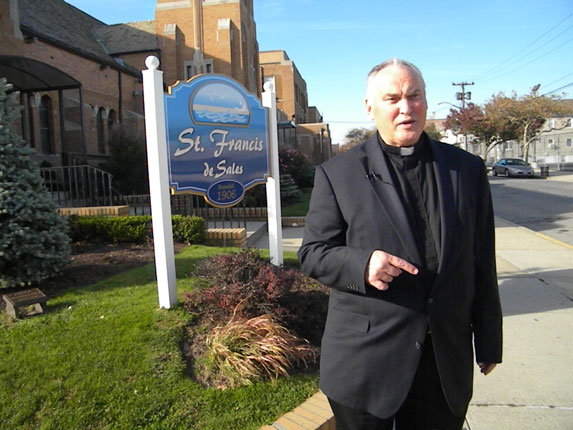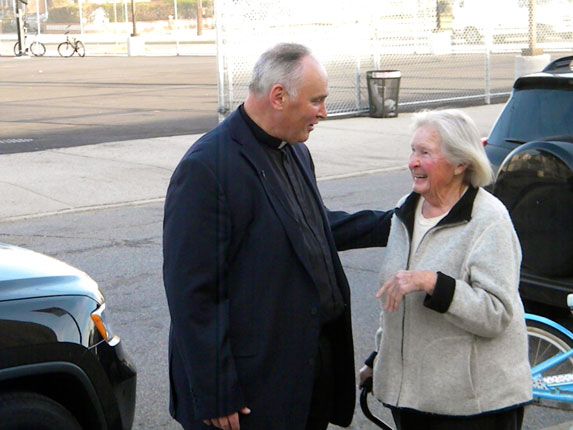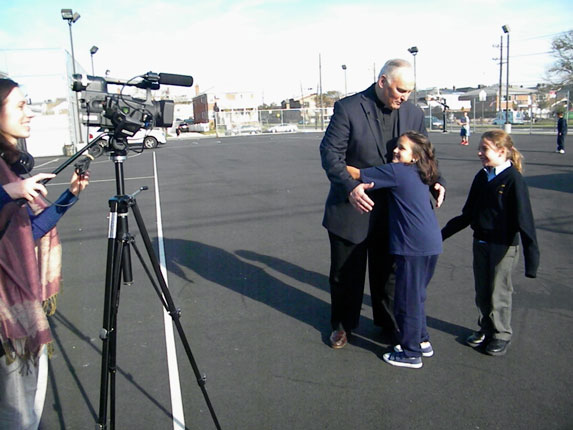
Msgr. John Brown said it still feels like yesterday.
The former pastor of St. Francis de Sales parish, Belle Harbor, will never forget the effects of Hurricane Sandy on the Rockaway community – even a full year later.
Oct. 29 marked the one-year anniversary of Sandy hitting the New York area, and Msgr. Brown can easily recall even minuscule details about the damage inflicted upon his parish and how the community emerged stronger than the storm.
“I spent the first day basically trying to walk around and comfort people,” he said. “Everybody was in shock. At that time, I remember thinking that I had to do something, but I didn’t know what to do.”
But he said it was the “hand of God” that allowed him and the Rockaway residents to persevere through the most difficult of times.
“Utter chaos” was the term he used to describe the day after the storm, so at one point, he just stopped and said a prayer, asking God for help because things were out of control.
Little by little though, progress toward recovery was being made. The gymnasium of the school building was used as a recovery center, where food and supplies were available. Eventually, the schoolyard transformed into a full-fledged disaster relief operation, with food and heating tents as well as a FEMA tent on the premise.
“I say this all the time, I didn’t start the disaster relief center…God did,” Msgr. Brown said. “And God pulled it forward to everything it needed to be to make sure that people were helped.”
Each day, this center offered aid to anywhere from 4,000 to 10,000 people – making it the central hub of the Rockaways in the storm’s immediate aftermath.
Msgr. Brown said that in conversations he would have with volunteers and parishioners, everyone agreed that God was present in the work being done.
“All through this, God answered all these prayers,” he said. “During the storm, from the first day to the last, I never felt like I was alone. I really believed that I’d get through this. It was long days, long nights, awkward times, difficult times, sad times, but I also knew that I was being cared for by God.
“Every day that we needed something, it showed up. It really was the hand of God constantly showing up. Every time I needed help, which was often, it came. In one form or another, it came.”
Though there were many defining moments for him during the long recovery process, Msgr. Brown spoke of a visit he received from the mayor of New Orleans, Mitch Landrieu, who had seen the monsignor on television and wanted to offer his services.
Landrieu had of course been through Hurricane Katrina in August, 2005, so he could relate to what Msgr. Brown was going through.
“He (Landrieu) said, ‘You know, Father, you need three things to survive something like this: He said you need a delicatessen because you need food; a school because you need education; and a church.
“He said, ‘Father you need a good church. You and this church are holding this community together. In New Orleans, everywhere we had a good church or temple, that neighborhood survived. Anywhere we didn’t, it fell apart.’ He said, ‘I know how hard this is, I know how painful it can be, but you have to keep that church together because we need it.’”
With the tireless support of the community and the reliance on God, the timetable of getting the parish and school up and running – based on the extent of the damage – was impressive. The parish offered daily Mass even though the church building had no heat or lights, and on Jan. 22 – just three months after the storm – the school was re-opened.
For his efforts, Msgr. Brown was named a finalist in the Congressional Medal of Honor Foundation’s Awards, in which he was cited for “your courage, your selflessness and you willingness to sacrifice for the good of others.” He said he believes the nomination was God’s way of saying thank you.
“I’ve always had a belief as priests that our assignments are for a reason,” Msgr. Brown said. “We may not know what the reason is until years later. Here at St. Francis, I think looking back at the seven years I was here, the reason I was here was that this storm was coming, and I could handle stress and handle disasters and being uncomfortable. It’s just part of my personality. So I was glad I was here to do it. I think that’s one of the gifts that God wanted me to use.”

Msgr. Brown is now the pastor of St. Thomas Aquinas, Flatlands, and he said returning for the one-year anniversary of Sandy brought on mixed emotions.
“A year later, I can look at it and say this is wonderful,” he said. “The gym is new; the school’s in good shape; there are things here and there that still need fixing. But we’ve survived it, and we’ve gotten through it.
“But lots of people are still suffering. Coming back here is a real treat for me to see my friends and see how better things are, but at the same time, I know how much pain people have gone through.”
He said that he would never look at a natural disaster the same way, since he now knows it’s not that simple to overcome the various challenges associated with providing relief.
He said years from now, people would of course remember the damage the storm caused, but he also said that the way the community united in the aftermath of the storm will not soon be forgotten.
“I hope five years from now people remember what the Church did – not me – as a community and as a Church with the help of God and the hand of God,” he said. “And that what we did as a Church is what the Church should do and what we can do when we work at it.”
Though there is still work to be done at St. Francis de Sales, the parish community has Msgr. Brown to thank for initiating a return to relative normalcy one year removed from the once-in-a-lifetime super storm.
“If we have a relationship with God, we can handle anything,” Msgr. Brown said. “I hope that’s what people remember.
“If I had one thing to leave with people, I would just leave, ‘Nothing’s impossible with God, stay close to God and one another and everything will get done.’”

